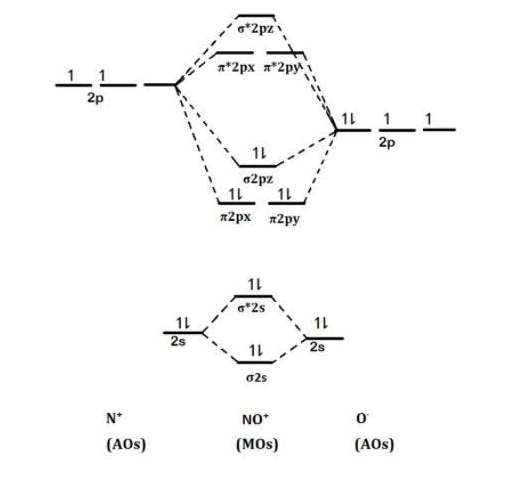Question
Question: The value of bond order in \(N{{O}^{+}}\) according to molecular orbital theory is: (A) 3 (B) 2 ...
The value of bond order in NO+ according to molecular orbital theory is:
(A) 3
(B) 2
(C) 1
(D) 0
Solution
The Molecular Orbital Theory (MOT) explains the formation of the molecule in a better way than Valence Bond Theory (VBT).
The bond order calculations are feasible using MOT and so is the description of electronic configuration.
Complete step by step answer:
Before solving the illustration given let us see about the VBT, MOT, bond order and magnetic property relations.
MOT and VBT are the foundational theories of quantum chemistry. The VBT gives a more understandable pictorial representation of molecules but, MOT explains the molecular formation in a better way. MOT describes the electronic structure of molecules using quantum mechanics.
According to MOT, the atomic orbitals of comparable energy undergo overlap and give the formation of the same number of molecular orbitals.
Addition of atomic orbitals-
The atomic orbitals with the same sign combine to give bonding molecular orbitals. In the molecular orbital, the region between the two nuclei is the place where there is overlap of individual orbitals. Hence, there is greater probability of electron density in this region.
MOT uses a linear combination of atomic orbitals strategy to represent molecular orbitals resulting from bonds between atoms. These are bonding, anti-bonding and non-bonding.
Now, let us see the MO diagram of NO+ molecule-

Molecular orbital electronic configuration is given by,
MOEC = KK(σ2s)2(σ∗2s)2(σ2pz)2[(π2px)2=(π2py)2]
where, KK denotes (σ1s)2(σ∗1s)2
Bonding orbitals are σ2s,σ2pz,π2px,π2py
Anti-bonding orbitals are σ∗2s
Therefore, Bond order = 2Nb−Na
Here, Nb denotes number of electrons in bonding molecular orbitals
Na denotes number of electrons in antibonding molecular orbitals
So, Bond order of NO+ = 28−2=3
Therefore, option (A) is correct.
Note: The bonding MO has lower energy and hence greater stability whereas, anti-bonding MO has more energy and hence lesser stability. That is why, electrons will be added or removed from antibonding orbitals first forming an ion.
